Md Saiful Islam
PARK: Parkinson's Analysis with Remote Kinetic-tasks
Nov 21, 2023

Abstract:We present a web-based framework to screen for Parkinson's disease (PD) by allowing users to perform neurological tests in their homes. Our web framework guides the users to complete three tasks involving speech, facial expression, and finger movements. The task videos are analyzed to classify whether the users show signs of PD. We present the results in an easy-to-understand manner, along with personalized resources to further access to treatment and care. Our framework is accessible by any major web browser, improving global access to neurological care.
Unmasking Parkinson's Disease with Smile: An AI-enabled Screening Framework
Aug 03, 2023



Abstract:Parkinson's disease (PD) diagnosis remains challenging due to lacking a reliable biomarker and limited access to clinical care. In this study, we present an analysis of the largest video dataset containing micro-expressions to screen for PD. We collected 3,871 videos from 1,059 unique participants, including 256 self-reported PD patients. The recordings are from diverse sources encompassing participants' homes across multiple countries, a clinic, and a PD care facility in the US. Leveraging facial landmarks and action units, we extracted features relevant to Hypomimia, a prominent symptom of PD characterized by reduced facial expressions. An ensemble of AI models trained on these features achieved an accuracy of 89.7% and an Area Under the Receiver Operating Characteristic (AUROC) of 89.3% while being free from detectable bias across population subgroups based on sex and ethnicity on held-out data. Further analysis reveals that features from the smiling videos alone lead to comparable performance, even on two external test sets the model has never seen during training, suggesting the potential for PD risk assessment from smiling selfie videos.
BlockTheFall: Wearable Device-based Fall Detection Framework Powered by Machine Learning and Blockchain for Elderly Care
Jun 10, 2023



Abstract:Falls among the elderly are a major health concern, frequently resulting in serious injuries and a reduced quality of life. In this paper, we propose "BlockTheFall," a wearable device-based fall detection framework which detects falls in real time by using sensor data from wearable devices. To accurately identify patterns and detect falls, the collected sensor data is analyzed using machine learning algorithms. To ensure data integrity and security, the framework stores and verifies fall event data using blockchain technology. The proposed framework aims to provide an efficient and dependable solution for fall detection with improved emergency response, and elderly individuals' overall well-being. Further experiments and evaluations are being carried out to validate the effectiveness and feasibility of the proposed framework, which has shown promising results in distinguishing genuine falls from simulated falls. By providing timely and accurate fall detection and response, this framework has the potential to substantially boost the quality of elderly care.
Using AI to Measure Parkinson's Disease Severity at Home
Apr 13, 2023Abstract:We present an artificial intelligence system to remotely assess the motor performance of individuals with Parkinson's disease (PD). Participants performed a motor task (i.e., tapping fingers) in front of a webcam, and data from 250 global participants were rated by three expert neurologists following the Movement Disorder Society Unified Parkinson's Disease Rating Scale (MDS-UPDRS). The neurologists' ratings were highly reliable, with an intra-class correlation coefficient (ICC) of 0.88. We developed computer algorithms to obtain objective measurements that align with the MDS-UPDRS guideline and are strongly correlated with the neurologists' ratings. Our machine learning model trained on these measures outperformed an MDS-UPDRS certified rater, with a mean absolute error (MAE) of 0.59 compared to the rater's MAE of 0.79. However, the model performed slightly worse than the expert neurologists (0.53 MAE). The methodology can be replicated for similar motor tasks, providing the possibility of evaluating individuals with PD and other movement disorders remotely, objectively, and in areas with limited access to neurological care.
TextMI: Textualize Multimodal Information for Integrating Non-verbal Cues in Pre-trained Language Models
Mar 29, 2023Abstract:Pre-trained large language models have recently achieved ground-breaking performance in a wide variety of language understanding tasks. However, the same model can not be applied to multimodal behavior understanding tasks (e.g., video sentiment/humor detection) unless non-verbal features (e.g., acoustic and visual) can be integrated with language. Jointly modeling multiple modalities significantly increases the model complexity, and makes the training process data-hungry. While an enormous amount of text data is available via the web, collecting large-scale multimodal behavioral video datasets is extremely expensive, both in terms of time and money. In this paper, we investigate whether large language models alone can successfully incorporate non-verbal information when they are presented in textual form. We present a way to convert the acoustic and visual information into corresponding textual descriptions and concatenate them with the spoken text. We feed this augmented input to a pre-trained BERT model and fine-tune it on three downstream multimodal tasks: sentiment, humor, and sarcasm detection. Our approach, TextMI, significantly reduces model complexity, adds interpretability to the model's decision, and can be applied for a diverse set of tasks while achieving superior (multimodal sarcasm detection) or near SOTA (multimodal sentiment analysis and multimodal humor detection) performance. We propose TextMI as a general, competitive baseline for multimodal behavioral analysis tasks, particularly in a low-resource setting.
NADBenchmarks -- a compilation of Benchmark Datasets for Machine Learning Tasks related to Natural Disasters
Dec 21, 2022Abstract:Climate change has increased the intensity, frequency, and duration of extreme weather events and natural disasters across the world. While the increased data on natural disasters improves the scope of machine learning (ML) in this field, progress is relatively slow. One bottleneck is the lack of benchmark datasets that would allow ML researchers to quantify their progress against a standard metric. The objective of this short paper is to explore the state of benchmark datasets for ML tasks related to natural disasters, categorizing them according to the disaster management cycle. We compile a list of existing benchmark datasets introduced in the past five years. We propose a web platform - NADBenchmarks - where researchers can search for benchmark datasets for natural disasters, and we develop a preliminary version of such a platform using our compiled list. This paper is intended to aid researchers in finding benchmark datasets to train their ML models on, and provide general directions for topics where they can contribute new benchmark datasets.
BAN-Cap: A Multi-Purpose English-Bangla Image Descriptions Dataset
May 28, 2022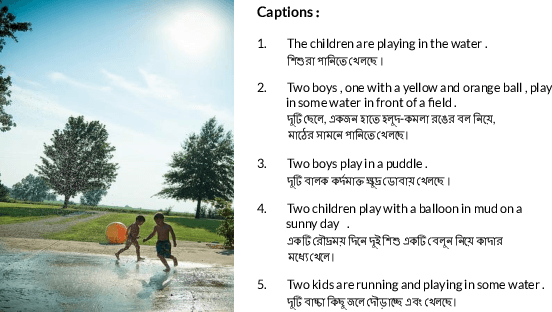

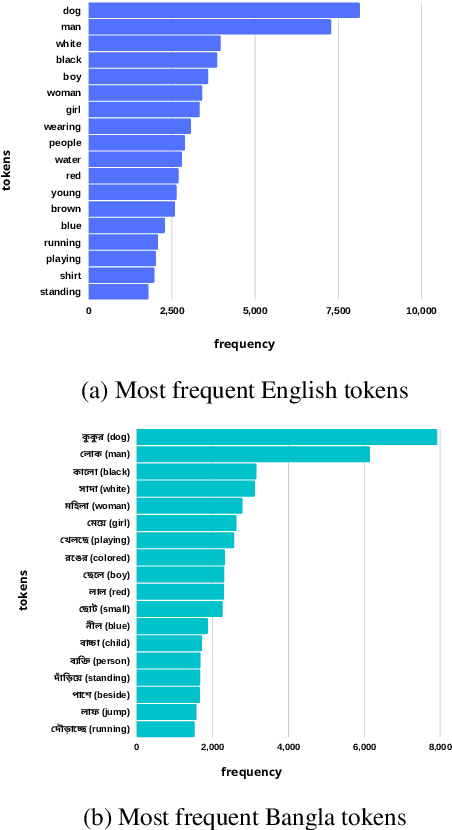

Abstract:As computers have become efficient at understanding visual information and transforming it into a written representation, research interest in tasks like automatic image captioning has seen a significant leap over the last few years. While most of the research attention is given to the English language in a monolingual setting, resource-constrained languages like Bangla remain out of focus, predominantly due to a lack of standard datasets. Addressing this issue, we present a new dataset BAN-Cap following the widely used Flickr8k dataset, where we collect Bangla captions of the images provided by qualified annotators. Our dataset represents a wider variety of image caption styles annotated by trained people from different backgrounds. We present a quantitative and qualitative analysis of the dataset and the baseline evaluation of the recent models in Bangla image captioning. We investigate the effect of text augmentation and demonstrate that an adaptive attention-based model combined with text augmentation using Contextualized Word Replacement (CWR) outperforms all state-of-the-art models for Bangla image captioning. We also present this dataset's multipurpose nature, especially on machine translation for Bangla-English and English-Bangla. This dataset and all the models will be useful for further research.
Auto-Gait: Automatic Ataxia Risk Assessment with Computer Vision on Gait Task Videos
Mar 15, 2022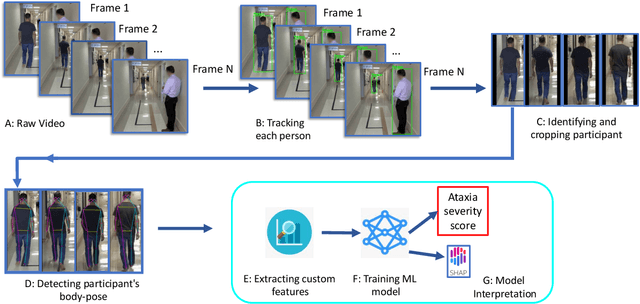

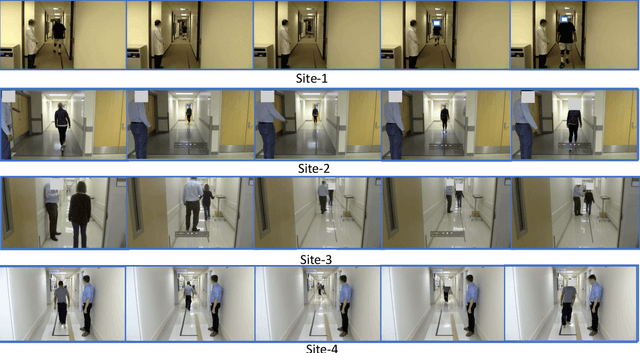
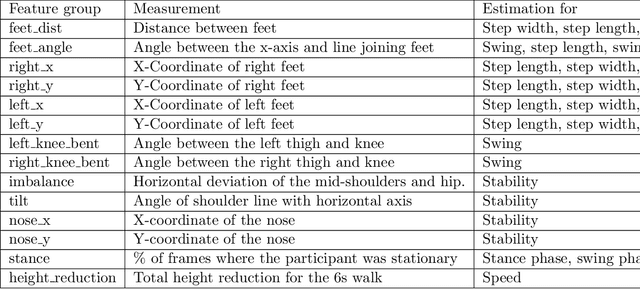
Abstract:In this paper, we investigated whether we can 1) detect participants with ataxia-specific gait characteristics (risk-prediction), and 2) assess severity of ataxia from gait (severity-assessment). We collected 155 videos from 89 participants, 24 controls and 65 diagnosed with (or are pre-manifest) spinocerebellar ataxias (SCAs), performing the gait task of the Scale for the Assessment and Rating of Ataxia (SARA) from 11 medical sites located in 8 different states in the United States. We developed a method to separate the participants from their surroundings and constructed several features to capture gait characteristics like step width, step length, swing, stability, speed, etc. Our risk-prediction model achieves 83.06% accuracy and an 80.23% F1 score. Similarly, our severity-assessment model achieves a mean absolute error (MAE) score of 0.6225 and a Pearson's correlation coefficient score of 0.7268. Our models still performed competitively when evaluated on data from sites not used during training. Furthermore, through feature importance analysis, we found that our models associate wider steps, decreased walking speed, and increased instability with greater ataxia severity, which is consistent with previously established clinical knowledge. Our models create possibilities for remote ataxia assessment in non-clinical settings in the future, which could significantly improve accessibility of ataxia care. Furthermore, our underlying dataset was assembled from a geographically diverse cohort, highlighting its potential to further increase equity. The code used in this study is open to the public, and the anonymized body pose landmark dataset could be released upon approval from our Institutional Review Board (IRB).
HS-BAN: A Benchmark Dataset of Social Media Comments for Hate Speech Detection in Bangla
Dec 03, 2021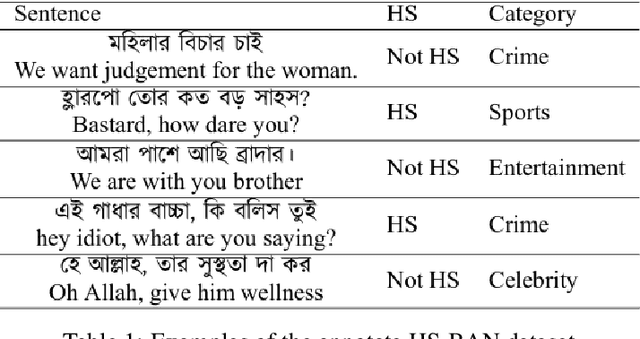
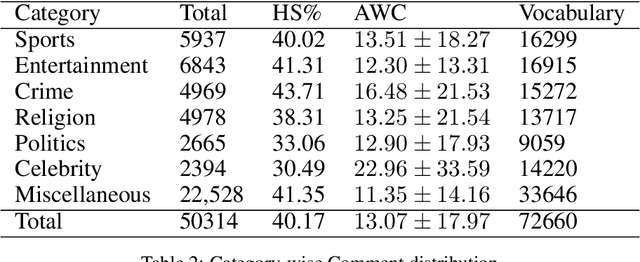
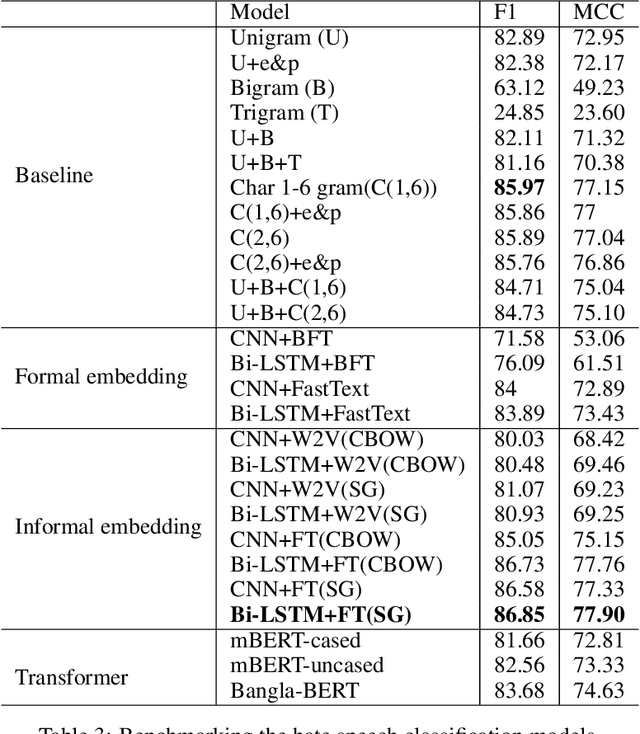
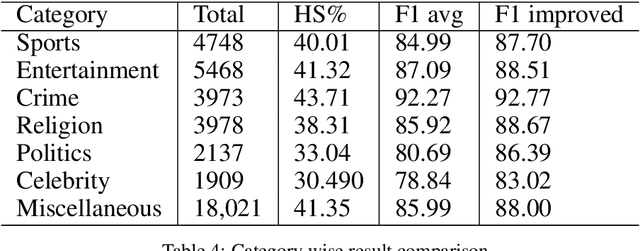
Abstract:In this paper, we present HS-BAN, a binary class hate speech (HS) dataset in Bangla language consisting of more than 50,000 labeled comments, including 40.17% hate and rest are non hate speech. While preparing the dataset a strict and detailed annotation guideline was followed to reduce human annotation bias. The HS dataset was also preprocessed linguistically to extract different types of slang currently people write using symbols, acronyms, or alternative spellings. These slang words were further categorized into traditional and non-traditional slang lists and included in the results of this paper. We explored traditional linguistic features and neural network-based methods to develop a benchmark system for hate speech detection for the Bangla language. Our experimental results show that existing word embedding models trained with informal texts perform better than those trained with formal text. Our benchmark shows that a Bi-LSTM model on top of the FastText informal word embedding achieved 86.78% F1-score. We will make the dataset available for public use.
Feature Selection for Causal Inference from High Dimensional Observational Data with Outcome Adaptive Elastic Net
Nov 27, 2021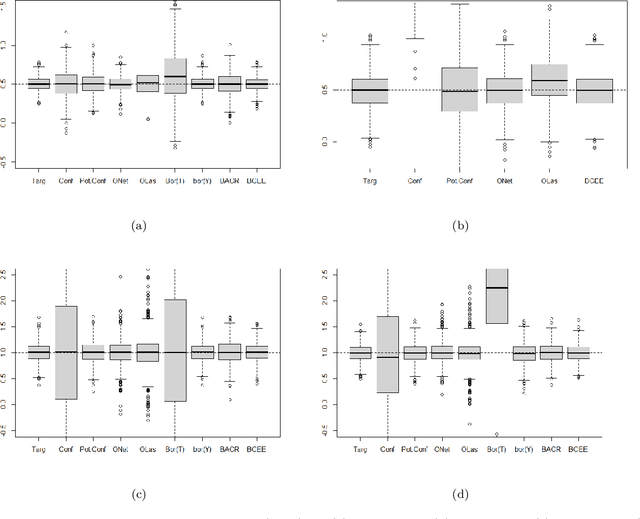
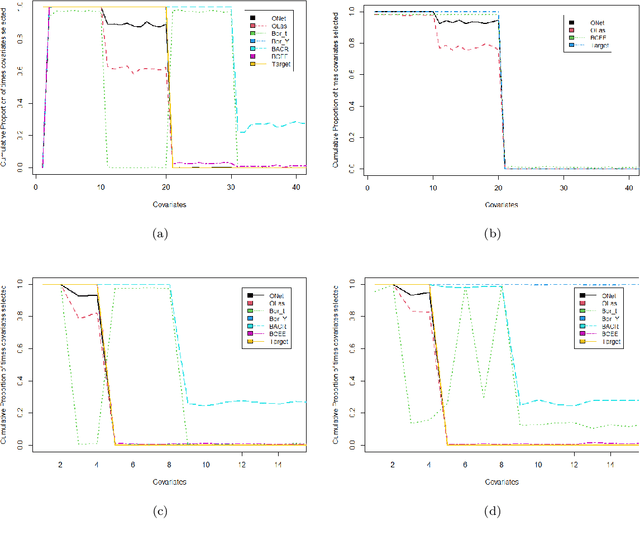
Abstract:Feature selection is an extensively studied technique in the machine learning literature where the main objective is to identify the subset of features that provides the highest predictive power. However, in causal inference, our goal is to identify the set of variables that are associated with both the treatment variable and outcome (i.e., the confounders). While controlling for the confounding variables helps us to achieve an unbiased estimate of causal effect, recent research shows that controlling for purely outcome predictors along with the confounders can reduce the variance of the estimate. In this paper, we propose an Outcome Adaptive Elastic-Net (OAENet) method specifically designed for causal inference to select the confounders and outcome predictors for inclusion in the propensity score model or in the matching mechanism. OAENet provides two major advantages over existing methods: it performs superiorly on correlated data, and it can be applied to any matching method and any estimates. In addition, OAENet is computationally efficient compared to state-of-the-art methods.
 Add to Chrome
Add to Chrome Add to Firefox
Add to Firefox Add to Edge
Add to Edge